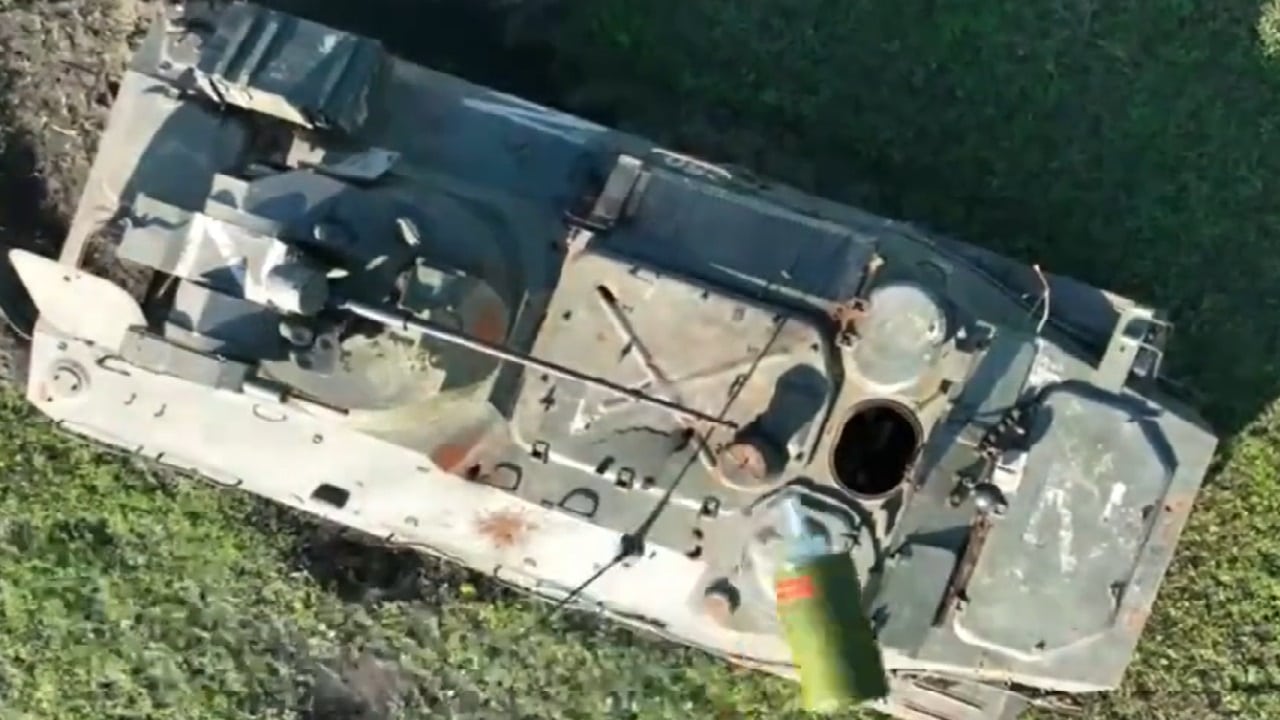Ukrainian Drone Makes a Grenade Hole in One – A Ukrainian drone operator showed off some skills last week in a video shared on social media.
In a 36-second-long clip, a commercial unmanned aerial vehicle (UAV) was employed to drop an RGT-27S2 thermobaric grenade into the hatch of a damaged Russian MT-LBM 6MB armored fighting vehicle.
The exact location of the incident wasn’t clear. Still, it highlighted the continued efforts by Ukrainian forces to ensure that damaged and disabled Russian vehicles aren’t returned to service for the Kremlin’s war machine.
Ukrainian forces have been reportedly employing Mavic 3 drones in the Donbas region, where operators have been specially trained to hover over targets and drop small ordnance, including the RGT-27S2 thermobaric grenades.
Heat It Up
The small cylindrical hand grenade was developed for use to clear out bunkers, trenches, and other enclosed spaces – but as it can create a fire cloud of 13m³ for four seconds, where temperatures reach upwards of 3,000 degrees Celsius (5,400 degrees Fahrenheit), it can also disable lightly armored vehicles.
The explosion of the small ordnance occurs in two stages. First, a small charge is detonated, which subsequently sprays a cloud of flammable substance in the immediate area. That is followed by a delayed detonation of a second charge, which sets off the cloud of aerosol.
Domestically Produced
RGT-27S and the rectangular-shaped RGT-27S2 grenades were developed by Artem State Enterprise, a part of Ukroboronprom. The ordnance was first presented publicly during a showcase of new weapons at the training ground in the Chernihiv region in 2017.
“The effectiveness of the Ukrainian enhanced blast weapons was tested at the training ground. There are, practically, no such weapons at the front line today. The RPO-16 hand-held rocket flamethrower proved to be very good,” the then-Secretary of the National Security and Defense Council of Ukraine Oleksandr Turchynov said in 2017 when the weapons were first publicly unveiled.
The RGT-27S and RGT-27S2 were adopted for officially service in 2020.
“Very few countries in the world have the technology to create thermobaric ammunition. These are the first weapons of this type developed in Ukraine, and they came about thanks to the fact that Ukroboronprom invests in science and people, and the development of its competencies,” Volodymyr Korobov, deputy director general for Aircraft Industry and Operations at Ukroboronprom, also noted in 2017.
A Russian MT-LB 6MB damaged by a Ukrainian UAV dropping a RGT-27S2 thermobaric grenade. https://t.co/YlnWg8JRrv pic.twitter.com/ATrsRtx52e
— Rob Lee (@RALee85) April 27, 2023
Russia’s Own Vacuum Bombs
Russia also possesses an arsenal of thermobaric weapons and had employed them against Ukrainian government forces deployed in the Donbas conflict area prior to its unprovoked invasion of Ukraine last year.
As previously reported, the Kremlin’s forces recently utilized a TOS-1A Solntsepek (‘Scorching Sun’) multiple rocket launcher system (MRLS), near the settlement in the Yasynuvata Raion (district) in the central Donetsk Oblast.
The Scorching Sun is an updated version of the TOS-1 ‘Burantino,’ a heavily armored rocket launcher that could launch incendiary and thermobaric rockets. It is meant to kill any “soft target” in its path. The rocket system fires thermobaric warheads to rain down death and destruction. The Russian military designates such weapons them “heavy flamethrowers.”
Thermobaric weapons are not unlawful or prohibited by the Geneva Convention. However, their use against civilian targets would violate the law of armed conflict (LOAC).
MORE: The F-35 Now Comes in Beast Mode
MORE: Why the U.S. Navy Tried to Sink Their Own Aircraft Carrier
Author Experience and Expertise:
A Senior Editor for 19FortyFive, Peter Suciu is a Michigan-based writer. He has contributed to more than four dozen magazines, newspapers, and websites with over 3,200 published pieces over a twenty-year career in journalism. He regularly writes about military hardware, firearms history, cybersecurity, politics, and international affairs. Peter is also a Contributing Writer for Forbes and Clearance Jobs. You can follow him on Twitter: @PeterSuciu.

